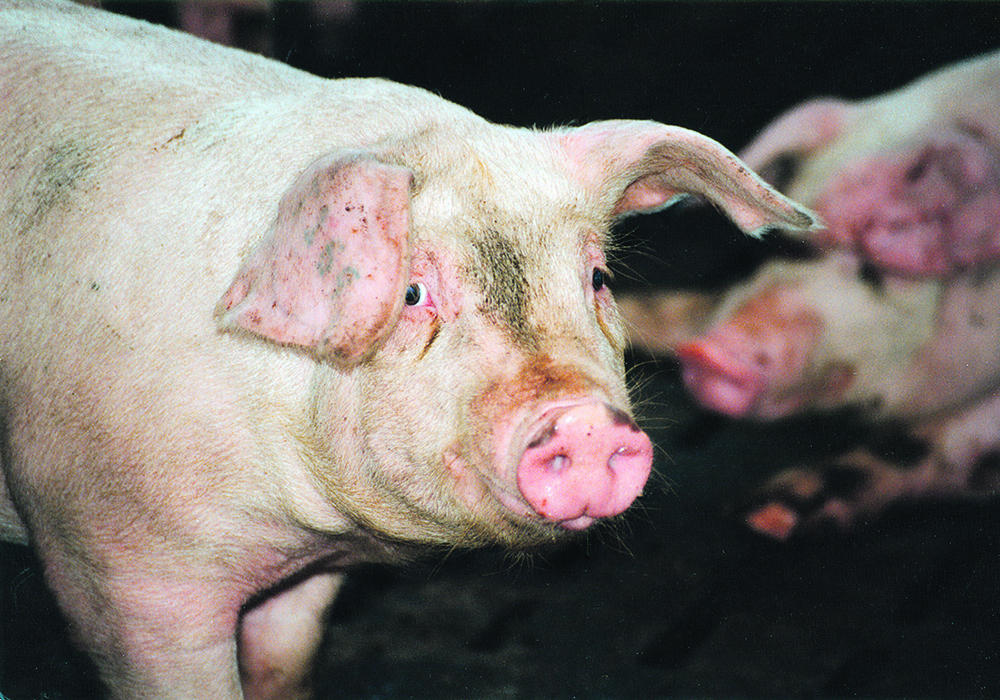Gastric ulcers are commonly found in pigs. Severe cases causing death account for one to two per cent of finisher farm mortality.
These ulcers, also known as stomach ulcers, are not a new phenomenon, first being reported in swine literature as early as 1897. However, the recent prevalence of mild to moderate cases showing some degree of lesions are reported to be five to 100 per cent across all pig producing countries.
Gastric ulcers cause loss of appetite, pallor, possibly rapid breathing, melena (black, tarry stool) and sudden death. Acute ulcers can lead to death within 24 hours of starting.
Read Also

Mixed results on new African swine fever vaccine
The new African swine fever vaccine still has issues, but also gave researchers insight into how virus strain impacts protection against the deadly pig disease.
Post mortem examination of these pigs reveal clotted and un-clotted blood in the stomach and extreme pallor.
Most pigs will have some degree of erosion of the stomach lining at some point in their life. As a result, pigs living with mild to moderate ulceration can exhibit slower growth but often lead healthy, productive lives.
The anatomy of the porcine stomach leaves parts of the lining quite susceptible to acid erosion.
Where the esophagus enters the stomach (pars esophagea), the non-glandular lining does not produce mucus or bicarbonate, which act to buffer the low pH and protect the stomach lining from the stomach acid. This is quite different from the glandular portions of the stomach lining, which are able to self-regulate and protect against acid damage.
The normal pars esophagea lining, which is 10 to 20 cells thick, does have an ineffective protective mechanism. When damaged, it will rapidly deposit more layers of epithelial cells, leading to thickened tissue 60 to 80 cells thick.
These rapidly produced — and immature — cells break down, allowing for digestive juices to access underlying tissues.
Three main factors are believed to contribute to the development of ulcers, none of them acting independently from the others:
• feed/nutrition
• stress
• health challenges
Ground grains in which the particle size is too fine is associated with ulcer development.
When pigs ingest a very fine diet of less than 500 microns, the physical nature of the tiny particles can interfere with mucus production and adhesion to the stomach lining, leaving the tissue susceptible to acid damage.
This disruption of the barrier can also lead to over-growth of some pathogens, such as Helicobacter suis, which are thought to increase inflammatory activity at the membrane and ulcer formation.
When common grains used in pig feed, such as corn and wheat, are processed through hammer mills, the kernels are shattered, leaving a lot of fine powdered grains.
As well, many farms will feed pelletized mash, which further reduces particle size.
Stress will increase ulcer generation in multiple ways.
Chronic stress, leading to elevated cortisol (stress hormone) levels, can lead to increased acid production and inhibition of the normal mechanism for the stomach to signal to reduce acid production.
At the same time that acid production increases, the parts of the stomach that produce the mucus and bicarbonate are instructed to reduce buffering capacity.
Both pathways facilitate acid damage to the pars esophagea lining.
Health challenges can have a direct impact, such as with the Heliobacter proliferation, but they also indirectly increase the likelihood of an ulcer developing or worsening.
Any situation that leads to empty stomachs will activate those acid-production pathways, while reducing the mucus/bicarbonate production mechanism. Many “empty stomach events” occur due to human or mechanical error, such as feed bins running empty, augers failing or feed bridges forming in the bin cone.
As well, health challenges that reduce appetite, even briefly, can affect ulcer expression on farms.
Respiratory challenges such as influenza and mycoplasma have been linked to sudden death involving ulcers.
We have tried treatments for ulcers such as Sucralfate or bicarbonate, usually in higher-value pigs such as replacement purebred or boar production, but most options have limited success.
There are several strategies to prevent or reduce the prevalence of ulcers, all aimed at the three risk factors. Farms must find a balance of reducing particle size to support efficient growth performance with the negative health impacts of the fine particle size.
A 100 micron reduction of particle size can improve feed efficiency by up to 1.25 per cent. This finer ground feed could be worth up to $1.52 per pig in reduced cost to the farm, or $41,000 for a 1,000 sow farm.
By using roller or disk mills, the average particle size can be maintained in an optimum range, while also reducing the variation of size and abundance of the fine/powdery feed.
Adjusting diet formulations to higher fibre levels, including barley or other available byproducts, can be beneficial.
Identifying stressors and reducing their impact can prevent ulcer development and produce other health benefits.
Farms should focus on management strategies to reduce stress, such as stocking densities in critical production phases, including when feeder access becomes limited.
As well, identifying and preventing feed outages is critical.
Managing health through sound vaccine and medication programs will also help reduce the effect that ulcers have on farms.
Using a combination of these strategies will help address the issue of undetected ulcers while at the same time improving hog farm economics.
Blaine Tully is a veterinarian and owner of Swine Health Professionals Ltd. in Steinbach, Man.















